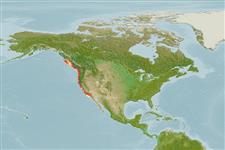Environment: milieu / climate zone / depth range / distribution range
पारिस्थितिकी
समुद्री ड़िमरसल; गहराई सीमा 84 - 368 m (Ref. 51666). Temperate; 55°N - 32°N
Eastern Pacific: British Columbia, Canada to San Diego in California, USA.
आकार / वज़न / Age
Maturity: Lm ? range ? - ? cm
Max length : 13.0 cm TL पुल्लिंग / अलिंग; (Ref. 2850)
Short description
आकृति विज्ञान | मौरफोमैटरिक्स
पृष्ठीय रीढ़ (सम्पूर्ण): 55 - 57; पृष्ठीय सौफट रेज़ (सम्पूर्ण): 0; गुदा कांटा 2; ऐनल सौफट रेज़: 34 - 35. Caudal rounded; lower 6 rays of pectorals elongated (Ref. 6885). Dusky olive brown dorsally, paler below; about 25 vertical light bars, narrower than intervening spaces, about 3 vague dark blotches spaced along side imposed on other pattern; dorsal fin with oblique dark bars, some intensified to make black blotches, especially toward posterior end; caudal, anal and pectoral fins with dark bars parallel to edge leaving a pale margin; sometimes a dark spot on inner dorsal margin of caudal fin; pelvic fins without markings (Ref. 6885).
Inhabits gravel and sand bottom (Ref. 51666).
Life cycle and mating behavior
परिपक्व अवधि | पुनरुत्पत्ति | मछलीऔ का अंडे देना | अंडे | Fecundity | लार्वा
Eschmeyer, W.N., E.S. Herald and H. Hammann, 1983. A field guide to Pacific coast fishes of North America. Boston (MA, USA): Houghton Mifflin Company. xii+336 p. (Ref. 2850)
IUCN Red List Status (Ref. 130435)
Threat to humans
Harmless
Human uses
अधिक जानकारी
आम नामउपशब्दचपायचयपरभक्षीईकोटोकसीकोलौजीपुनरुत्पत्तिपरिपक्व अवधिमछलीऔ का अंडे देनाSpawning aggregationFecundityअंडेEgg development
Age/Sizeबाढ़Length-weightLength-lengthLength-frequenciesमौरफोमैटरिक्सआकृति विज्ञानलार्वालारवल गतिकीभर्तीबहुतायतBRUVS
संदर्भजलीयकृषिजलीयकृषि रूपरेखाखींचआनुवंशिकीElectrophoresesहैरेटिबिलटीबीमारीप्रक्रमणNutrientsMass conversion
सहयोगीयोतस्वीरेStamps, Coins Misc.ध्वनिसिगुयटिरारफ्तारतैरने के प्रकारगिल क्षेत्रOtolithsदिमागदृष्टि
साधन
Special reports
Download XML
इंटरनेट स्रोत
Estimates based on models
Preferred temperature (Ref.
123201): 6.3 - 8.8, mean 7.3 °C (based on 34 cells).
Phylogenetic diversity index (Ref.
82804): PD
50 = 1.0000 [Uniqueness, from 0.5 = low to 2.0 = high].
Bayesian length-weight: a=0.00389 (0.00180 - 0.00842), b=3.12 (2.94 - 3.30), in cm total length, based on all LWR estimates for this body shape (Ref.
93245).
Trophic level (Ref.
69278): 3.2 ±0.5 se; based on size and trophs of closest relatives
Fishing Vulnerability (Ref.
59153): Low vulnerability (10 of 100).
